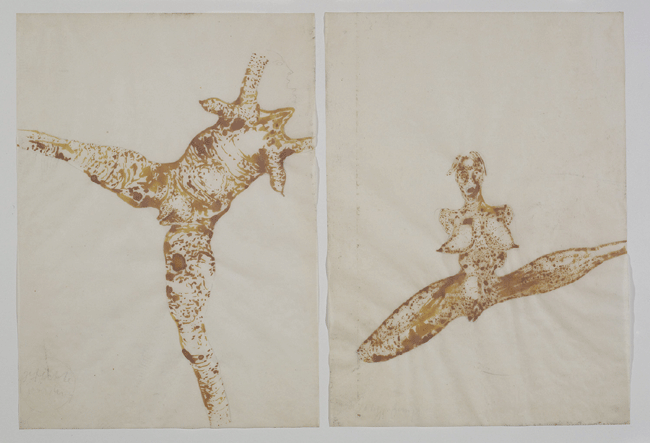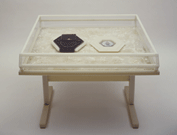This exhibition which had its premiere in 2006 at the Deutsche Guggenheim, the unique joint venture between Deutsche Bank and the Solomon R. Guggenheim Foundation in Berlin, examines affinities between the two artists, who, though separated by generation and geography, share certain key aesthetic and conceptual concerns. Drawn largely from the Guggenheim Museum’s in-depth holdings of works by Barney and Beuys, the exhibition examines the metaphoric use of materials, the focus on metamorphosis, and the relationship between action and its documentation in their respective practices. It also reveals fundamental, philosophical differences between Barney and Beuys -fueled by the divide between modern and postmodernist thought - that, in turn, further enhances our understanding of each artist's work.
A shared graphic sensibility
The exhibition features a broad selection of works on paper by each artist, which demonstrates a shared graphic sensibility and the centrality of drawing to each of their oeuvres. Sketches of sculptural processes, organic systems, and metamorphic passages by both Barney and Beuys are composed with a similar delicate, almost tentative line. Whether emanating from existing work, preceding it in a catalytic manner, or being realized as part of a performance, drawing reveals the conceptual underpinnings of their practices. Iconographically, the drawings chart each artist’s absorption in transformative processes and personal cosmologies. Beuys used the cruciform shape as a graphic symbol for his conviction that art could function as a therapeutic force in the world. As a logo, it presages Barney’s use of the “field emblem” as an identifying marker in his work. An ellipsis bisected horizontally by a single bar, the symbol represents a body disciplined by restraint, a flow of raw energy held in check, an arena of pure potential.
A microcosm of each artist’s aesthetic and conceptual system
The sculptures on view each distil a complex narrative into discernable form, creating a microcosm of each artist’s aesthetic and conceptual system. Barney’s Chrysler Imperial (2002) encapsulates sequences from the final film of his five-part CREMASTER cycle( (1994-2003), which summarizes his essential themes. As an abridged version of the cycle, Chrysler Imperial exemplifies how Barney shapes cinematic narrative into sculptural dimensions—using his signature Vaseline and cast plastics—to extrapolate in space what he explores in time. Beuys likewise infuses eccentric materials with metaphor in Honigpumpe am Arbeitsplatz (Honey Pump at the Workplace) (1977), a work that sculpturally articulates the activities that occurred during Documenta VI in Kassel, Germany in 1977. Two tons of honey were pumped via a system of pipes and tubes from the stairwell of the Kunsthalle Fridericianum through the spaces where discussions, seminars, films, and demonstrations were staged by The Free International University. Beuys associated the circulating honey with warmth and energy. It signified the potential of the FIU, which equated creativity with social activism, to infiltrate mainstream society. Afterwards, the installation was dismantled and exhibited in its static state. The exhibition aims to explore, in the works of both artists, the relationship between live performance and the presentation of its documentation along with the objects it generates.
Vitrines
Beuys’s glass vitrines evoke the display mechanisms of both the fine art and natural history museum. The dual reference forwards his argument that art cannot be understood separately from either the social or organic worlds. The vitrine from 1983 includes Fat Filter( (1964) and Sledge (1969), a multiple that invokes the theme of survival at the core of Beuys’s personal mythology. Another vitrine from 1984 features artifacts from a 1974 action in Pescara titled Incontro con Beuys, ( which refer to his concepts of insulation and energy production: a copper plate wrapped in felt and Italian sausages that Beuys sliced during the performance. For Barney, the vitrine offered a solution for the presentation of his editioned CREMASTER films as sculpture. CREMASTER 2 ( (1999), which deployed the story of Mormon murderer Gary Gilmore as a narrative armature for Barney’s exegesis on the conflict between fate and will, engendered a vitrine lined with honeycomb—a reference to Utah’s state emblem of the beehive. CREMASTER 3( (2002), which utilizes the partition of Ireland as a structural element, generated a vitrine constructed from green and orange plastic, the colors of the Irish flag.
Illustration: Matthew BarneyCREMASTER 2, 1999 Silkscreened digital video disk, nylon, tooled saddle leather, sterling silver, beeswax, and polycarbonate honeycomb in nylon and acrylic vitrine, with 35mm print; color digital video transferred to film with Dolby SR sound, 1:19:00 Edition 8/10 + 2 A.P. 38 3/8 x 40 x 46 5/8 inches (97.5 x 101.6 x 118.4 cm) overall. Solomon R. Guggenheim Museum New York. Purchased with funds contributed by the International Director's Council and Executive Committee Members. 99.5303 Photo by Ellen Labenski, © Solomon R. Guggenheim Foundation, New York © 2007 Matthew Barney. Used by permission. All rights reserved
PUBLICATION
Fully-illustrated catalogue in Italian or English, with texts by Spector, Christian Scheidemann, Mark Taylor, and Nat Trotman.
This exhibition is made possible by RIGroup.
Major exhibition sponsorship provided by Deutsche Bank.
Programs of the Peggy Guggenheim Collection are supported by the Advisory Board, the Banca del Gottardo, the Regione del Veneto and Intrapresae Collezione Guggenheim.
| 

